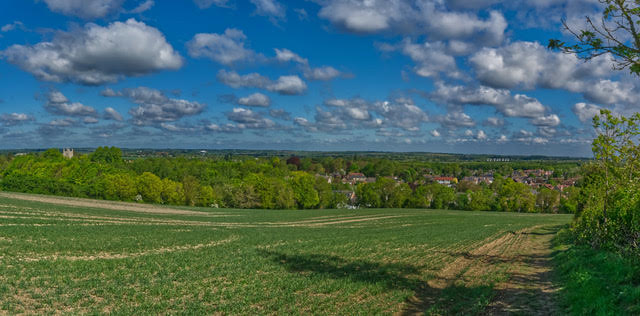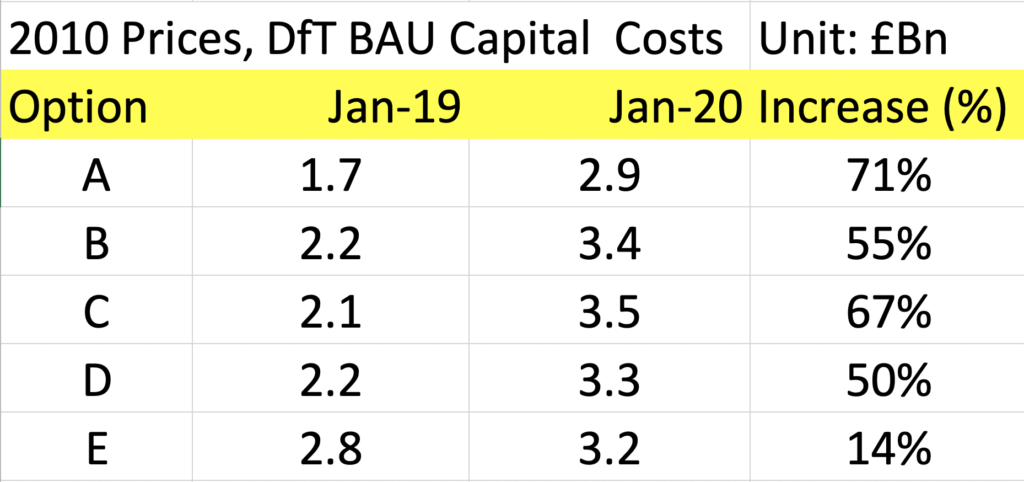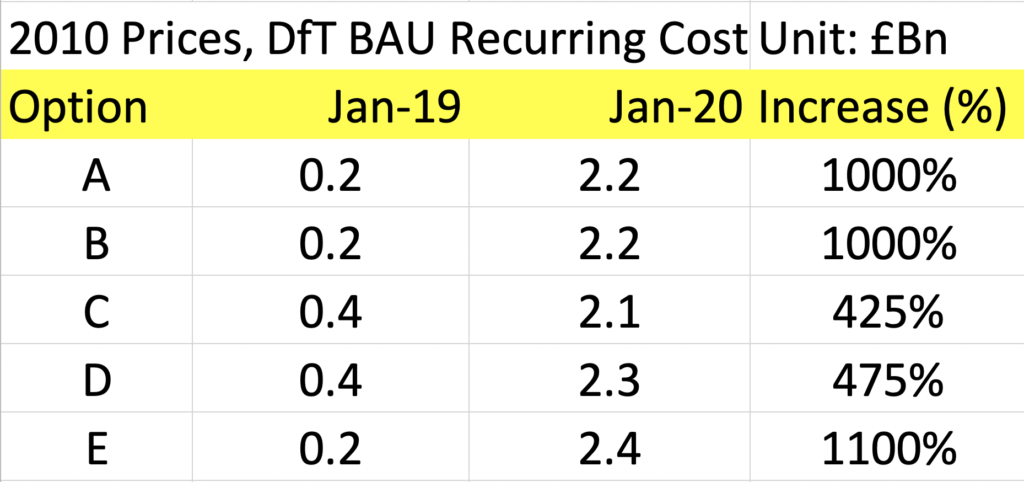
EWR Co. have given us two snapshots of their cost estimates for the East West Railway Central Section (i.e. Bedford to Cambridge). Firstly, at the time of the last public consultation in January 2019 in Table 3 of the Technical Report[1] and then again in January 2020 when they announced the Option E decision in their Route Option Report[2]. Note that all figures are in 2010 prices so we have to add around 15.6% to get to 2019 prices.
Both reports give the total costs for each route option and then break them down into upfront capital costs and recurring costs over 60 years according to the Department for Transport methodology. The recurring[3] costs are the “infrastructure and renewal costs” (called “whole life costs” in the 2020 report, we assume that these are the same thing), operational costs and fare revenues.
This analysis is done from the taxpayer’s point of view so fare revenue is treated as a cost, because the taxpayer has to pay the fares to use the trains.
The Option Report also gives figures using a more optimistic (we think very optimistic) NIC high growth assumption and the costs are higher. The cost figures we give here are the lower “Department for Transport (DfT) Business as Usual” (BAU) figures.
The three tables below show the total, capital and recurring costs. The total is just the sum of the capital and recurring costs. The figures in the table are the costs in the Technical Report, the costs in the Option Report and the percentage increase from one to the other.



First impressions looking at the data:
- all the total costs went up hugely and, since EWR Co. did not present a comparison, they made no comments about why this has happened.
- the recurring costs went up by so much it gives one very little confidence that they are right. If they are right now, then they were very misleading at the consultation.
- the capital cost for Option E rose by much less than the other options and no explanation is given. However, it is certainly a useful result for EWR Co. as it allows them to justify the choice of Option E since it was otherwise the most expensive of the 5 options.
- The total cost figures for 4 of the options are identical – this may be an unlikely coincidence or possibly that the cost estimates have not been produced with the expected amount of rigour.
Note 33 on p.100 of the Option Report states that for the DfT BAU table 15.4 (the data we presented above), the Bassingbourn station is removed in Options A, C and D, while for the NIC high growth table 15.5 the station is left in. It then says that the capital costs therefore differ between the growth scenarios for these route options.
However, we find that while the capital costs of A and D do go up by £0.3 and £0.2 billion respectively, to allow for the additional station, the capital cost of Option C is unchanged at £3.5 billion. Option C is therefore anomalous.
Looking again at table 15.4 the revenues for Options A, C and D are not significantly lower than Options B and E even though they have one less station. How can that be?
Questions for East West Rail
- Please can you explain the huge increase in capital cost between the figures in table 3 of the Technical Report and Table 15.4 of the Options Report?
- Why did the recurring costs (the difference between the total costs and the capital costs) go up by up to 1100% between the same two reports?
- In the light of the order of magnitude increase in recurring costs, does that mean that the recurring costs implied at the time of the public consultation were misleading? If not, why not?
- In the light of the order of magnitude increase in recurring costs, how can we have confidence that the figures currently presented are anything like correct?
- Why did the capital cost of the chosen Option E uniquely rise by so much less than the other options? This is the main reason why the most expensive option in January 2019, became the one with the highest BCR in January 2020. Without an explanation of this cost increase, this BCR justification of Option E is meaningless. So please give a detailed explanation.
- What was the cost given by the MoD to remove their Bassingbourn site and what alternatives were looked at?
- Given that Options A, C and D did not have a station at Bassingbourn in Table 15.4 why was there no visible impact on the revenues, whole life costs or operating costs?
- Given that you state in note 33 on p.100 of the 2020 Options Report that the removal of Bassingbourn Station reduces the capital cost, why is the capital cost identical for Route C in Tables 15.4 and 15.5 of the same report?
[1] East West Rail Bedford to Cambridge Route Option Consultation Technical Report January 2019 Table 3, p.40
[2] East West Rail Bedford to Cambridge Preferred Route Option Report January 2020 Table 15.4, p.100
[3] EWR Co. do not give these a name, but we refer to them here as recurring costs.
2 replies on “Unexplained Cost Increases for the EWR Central Section”
Is there no way that the Northern route can be linked in to run through Cambridge and Cambridge South and then on to Felixstowe? Passengers to the Addenbrooke’s site would use Cambridge South.
[…] However, in the course of performing its work, the CAG has reached the conclusion that East West Railway Company’s decision to choose Route Option E is fundamentally flawed. The CAG is now beginning a process of campaigning for a review of that decision. It is demanding a full and fair evaluation of all possible approaches into Cambridge – both to a north Cambridge or a south Cambridge station. You can find important discussion of the CAG’s developing challenge to the business case that led to the choice of Route Option E on th…. […]